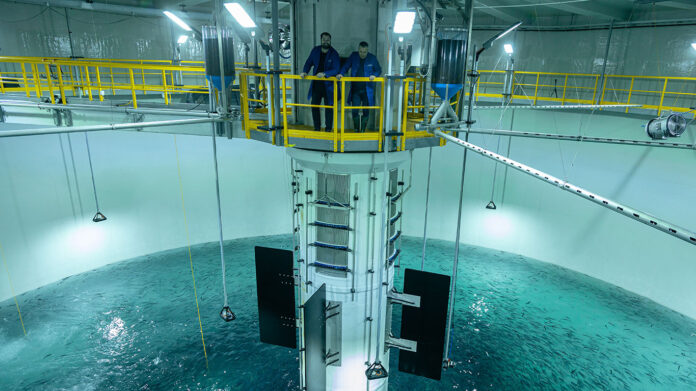The land-based salmon farming industry is rapidly moving from infancy to a more mature industry. The early years have been riddled with biological trouble stemming from a combination of unrealistic bio planning and sub-optimal system designs resulting in H2S formation as well as suboptimal rearing temperatures.
All of the early pioneers have struggled to reach the originally intended production. This is perceived to be the result of optimistic growth expectations, that has resulted in unrealistic production planning, which in turn has resulted in facilities with inadequate rearing volume. Some of the early facilities now seem to have solved many of the early problems and have started to report profitable operations. They are still, however, producing about 120-140 kg/ m3/ year. This is an index figure showing productivity per rearing volume and should not be confused with stocking density, which is obviously much lower.
Some of the shortfalls in production have been attributed to the fish being reared in RAS systems, and hence a new trend with land-based flow-through systems catching the eyes of investors, promising better fish welfare and better growth. The question remains whether that sentiment has merit. New reporting from flow-through front runner Salmon Evolution sheds some light on the subject.
Salmon Evolution presented their half year results, as well as an operational update on the 15th of August. The facility was built with an aim of producing 7,900 tons HOG 4.7 kg fish (approximately 9,200 tons LWE) and the first smolt was transferred to the facility in March 2022. Salmon Evolution’s facility is equipped with 12 tanks with 4,800 m3 of rearing volume or a total of 57,600 m3. The corresponding production index number of 160 kg/ m3/ year.
As Salmon Evolution employs temperature regulation with intended rearing temperature of 12-14 °C, their production data is ideal for direct comparison to that of RAS facilities that also employ temperature regulation.
Albeit Q2-2024 saw an impressive harvest of 1,581 tons the company is now anticipating harvest volumes for Q3 and Q4 of 1,200-1,300 tons per quarter. This would result in a total production of 5,000 tons HOG in 2024 which is 63% of the originally intended 7,900 tons HOG equivalents.
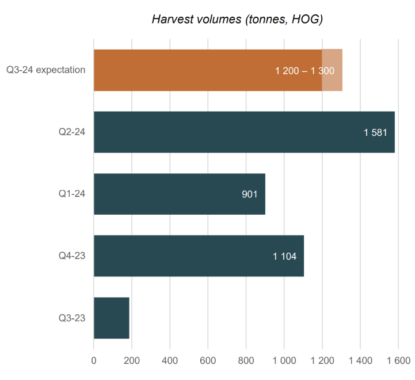
Salmon Evolution harvested fish with an average size of 3.6 kg in the quarter. This is substantially lower than the target production size of around 4.7 kg. As reported, this was done due to strong pricing in the market. Early harvest of smaller fish can have merit for commercial reasons, so this is likely a very sound business decision. It should also be said that decreasing harvest size will allow a facility to increase harvest volumes, as smaller fish grows faster than larger fish and the overall facility utilisation increases. It does, however also, require input of a higher number of smolts.
It was however also reported, which is more important for this analysis, that one of the reasons for the low average harvest weight was low average stocking weights during spring/ summer 2023. Based on earlier reporting it is correct that the inserts in May, June and August 2023 were considerably smaller, with an average size of 84g. Earlier inserts from March 2022 to February 2023 had average smolt sizes of 231g.
Growth data
Salmon Evolution reported monthly growth data from March 2022 and until September 2023 for the first eight (8) batches. The data includes growth in the weight interval of 80-4,700 g. The reporting of growth data was hereafter discontinued, and the company opted to report only standing biomass and harvest numbers. The new production update, however, gives a few hints on the current situation.
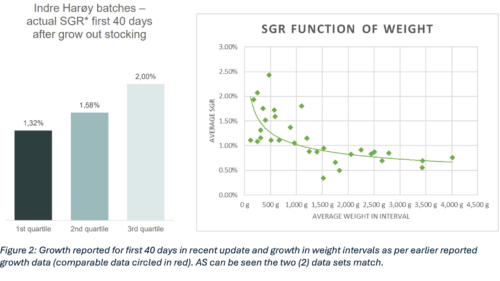
Salmon Evolution reported SGR for the first 40 days in the system as can be seen in Figure 2. The 1st quartile (or lower quartile) refers to the growth in the first 40 days of the 25% of batches that grew the slowest, while the 2nd quartile refers to the 50% of batches in the middle, whilst the 3rd quartile contains the 25% of fastest growing batches. With about 12 datapoints in the dataset each quartile should contain 3,6 and 3 datapoints respectively. Based on the earlier reported data, the fastest growing batches in the initial phase were batch 2, 7 and 8, where the fish were stocked with an average weight of 95 g. It is not surprising that these batches grew faster than the other batches, as small fish tend to grow faster than larger fish, as it is also clearly depicted in the graph in figure 2.
The initial growth of the five (5) remaining batches in the dataset was 1.25%. The average weight of these batches at stocking was 224g. It is therefore likely that at least some of these batches constitute the datapoints in the 1st quartile and that batches 9-12 are likely to be found in the 2nd quartile. There are however no reports on the smolt size of these batches at insert. A good guess would be about 150 g based on the reported growth in the first 40 days post insert.
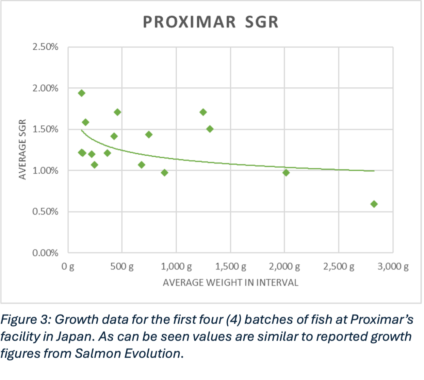
It should be noted that the earlier reported data showed most batches picked up growth and grew faster after a while in the system. This indicates a certain acclimatisation period is required after transfer. This is also not surprising and can be seen on similar datasets from other land-based RAS systems and the flow through system belonging to Andfjord Salmon.
The calculated growth is similar to growth data reported to the market from Proximar’s facility in Japan, as shown in Figure 3. There is therefore little evidence that the fish grows faster in a flow-through facility than in a RAS facility.
Productivity and harvest volume
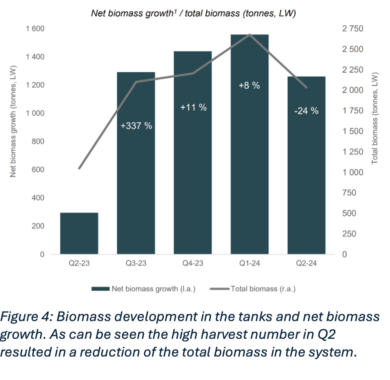
As can be seen in figure 4 the Q2-24 net biomass growth is lower than both Q3-24 and Q4-23. This indicates that the system will require some time to ramp up before it reaches the record Q2-24 harvest output again that was achieved on the back of good Net Biomass Growth in previous quarters. As can also be seen the highest net biomass growth (LWE) has been 1,600 tons/ quarter. It remains to be seen whether production can be boosted beyond the 1,600 tons/ quarter mark and if it can be achieved consecutively over the entire year. A net biomass growth of 1,600 tons per quarter translates into a production of 6,400 tons LWE or 5,440 tons HOG/ year. To reach target production the requirement would be a Net Biomass Growth of 2,300 tons/ quarter or 44% more than the best quarter to this date.
The company has analysed the effects of specific incidents and estimated effects of “one-offs” that has reduced the output in 2024 with a total of 2,000 tons. The mentioned reasons are the low stocking size of batch 6-8 and reduced stocking number of Batch 10 and culling of Batch 11. Inserting larger smolts has therefore been identified as a key to achieving production targets.
Therefore, Salmon Evolution has identified a mitigation strategy for reaching and potentially exceeding their production target. They are planning to build one (1) or two (2) new pre-growout systems, that will rely on already existing water and power infrastructure at site. This is considered to be a good strategy as it is also likely to increase utilization of the main growout section, as tanks are likely to have low stocking density when they are initially stocked with smolt (>15 kg/m3).
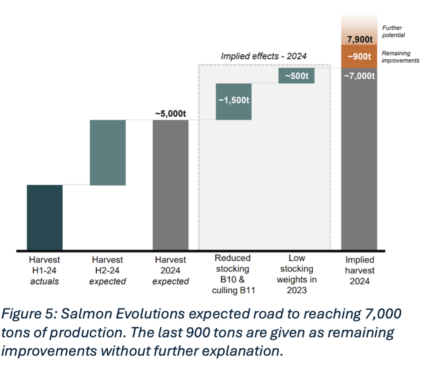 Conclusion
Conclusion
Given the information presented and subsequent analysis it is deemed likely that Salmon Evolution will face challenges with achieving the originally intended production with the current setup. Based on the analysis the production capacity of the system is currently perceived to be 7,600-8,100 tons per year or 6,500-6,900 tons HOG. This will result in a benchmark production index range of 131-140 kg/ m3/ year. This is in line with what has been achieved in RAS facilities. It should be emphasised that this is in the high range of production index numbers achieved in land-based growout facilities, and in itself would be considered as a considerable achievement. Salmon Evolution would thus be performing among the best in class, but are not beating the market.
It is likely that the company’s strategy with building pre-growout units will increase the output to the originally intended production of 9,200 tons per year or 7,900 tons HOG per phase of 12 growout tanks. With reservations for the final size of the pre-growout units it is unlikely to increase the production above originally planned output, as the company expects with the completion of phase 2 and the pre-growout unit. This conclusion is based on the reported maximum Net Biomass Growth, Production Index Number of the facility and the fact that the fish does not appear to be growing faster than in other land based systems.
The reported data suggests that better growth is not achieved in flow-through compared to RAS systems. The most important factor, when designing and planning new facilities, remains provision of adequate rearing volume securing required system flexibility and resilience. This will give the operator the means to reach production business targets year-on-year. Rearing volume comes with a price, but it better to plan bigger and with higher initial CAPEX and not fail on production targets. There is multiple datapoints to support this conclusion, but it remains to be seen whether all future projects are planned in accordance with this.
Morten Bjørn will be present at Aqua 2024 next week in Copenhagen. If you would like to discuss these findings or other related topics, feel free to reach out to him during the event.

